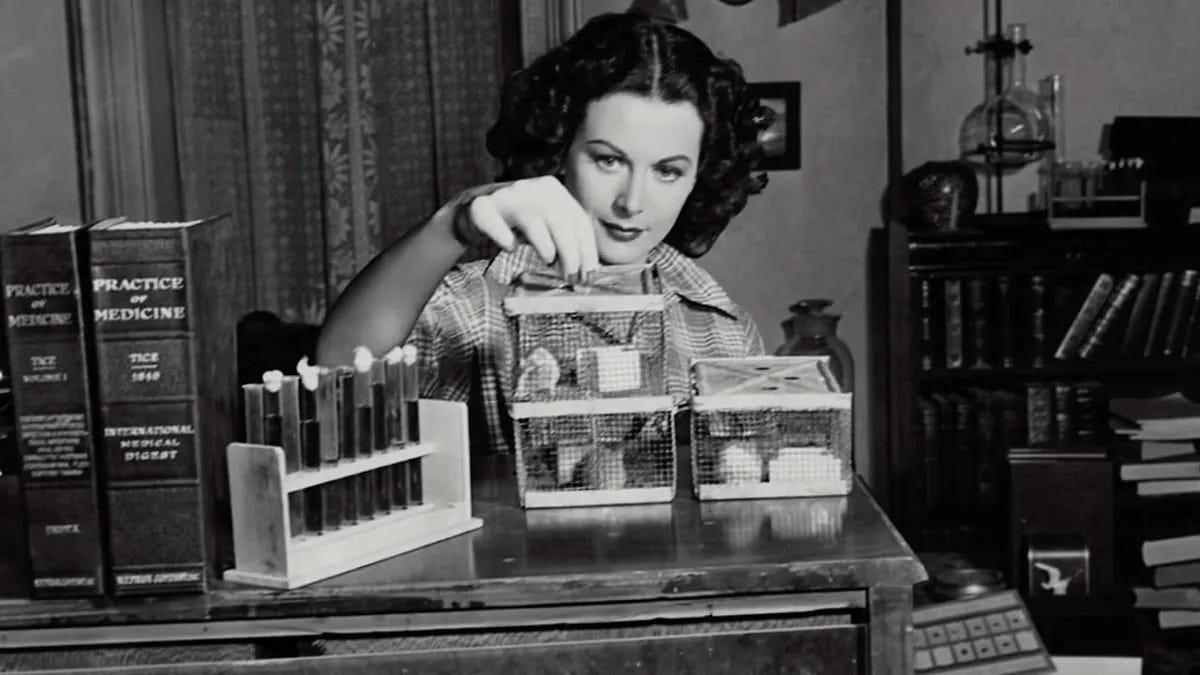the woman responsible for your screen time
hedy lamarr's invention laid the ground work for wifi and an equitable web for all
hedy lamarr would hate the “i’m too pretty to work” meme because that’s exactly how she was treated. the old hollywood actress was once dubbed “the most beautiful woman in film” and was cited as the inspiration for snow white, yet she came up with multiple inventions most people don’t know of today. the most famous of her inventions is, of course, the entire reason you’re able to read this post and i’m able to make a living. yet her technology was never adapted for its purpose of serving world war 2 soldiers because she was written off as a pretty actress - what could she know about actual technology? if hedy’s frequency hopping was adapted sooner, the war could’ve been over sooner which means countless lives would’ve been saved.
but men would rather die than have a woman teach them something useful.
“any girl can be glamorous, all you have to do is stand still and look stupid.”
-hedy lamarr
hedy lamarr was born in austria in 1914. she would often go on long walks with her father in the city, who’d explain to her how street cars work and how their electricity was generated. she had a natural affinity for engineering but that career path wasn’t available to girls in the 1930s - that’s far too inappropriate for a girl to learn! luckily there’s always one path available to young girls: being professionally hot. kidding (sort of) but hedy did love acting. in fact, she forged a sick note as a 16 year old so she could sneak off to downtown vienna and get herself hired at a film production company.
hedy acted in small roles until age 18 when she was given the lead in a film called ecstasy. now i know your alarm bells are going off hearing about an 18 year old starring in a film called ecstasy but i was surprised to find out how ahead of his time it was. in it, hedy played a neglected young wife who has a passionate affair, and ecstasy became the first ever film to showcase a woman receiving pleasure on screen. the film was banned in the US and germany for that reason - and not the reason that an 18 year old had a nude scene and was playing alongside a 32 year old male actor. some things never change!
considering the time she lived in and the industry she worked in, hedy retained a pretty impressive control of her own career and image. she married a weapons manufacturer and eventually divorced him because he was so boring and, well, a weapons manufacturers. yet it was with him that hedy learned a lot about how weapons worked, which would inform the technology of her future inventions.
in 1937, hedy fled to the united states and negotiated a pretty impressive $500/week contract to act for mgm studios. she did this by booking a ticket on a luxury ship that a film executive was traveling on, and made sure she was being seen looking beautiful and playing tennis with handsome men on board. it didn’t take long for her to emerge as hollywood’s brightest new star. her first breakout role was in a 1938 film called algiers and from there, mgm had her working in multiple feature films a year.
whether in acting or using her beauty, hedy liked to be in control. inventing was her biggest passion. she’d often skip hollywood parties to return to her “inventing spaces” - one was a room in her house dedicated to her musings and another, a table in her studio trailer to sketch our ideas while waiting in between shooting scenes.
hedy invented a glow-in-the-dark dog collar, a tissue-box attachment to dispose used tissues in, and a shower seat for elderly people that swiveled safely out of the bathtub. a lot of people in the scientific community refused to give her credit, using misogynistic excuses as “a beautiful hollywood star could not invent something so brilliant.”
but none of these comments stopped her because hedy was never doing it for the praise. she genuinely loved knowledge. besides, her hollywood roles were usually one-dimensional and emphasized her beauty, which bored her. hedy’s walls were lined with engineering and science books to aid in her ideas coming to life - a sort of vintage search engine. hedy’s drive for knowledge and self-actualization would lead her to invent the technology for wifi and to make the internet more accessible for all.
in 1940, hedy learns of the nazi war machine steadily gaining territory and using submarines to sink allied ships, especially ones carrying escaping refugees and children. nazis would intercept the signal of allied torpedos, and reroute the torpedos to cause havoc on these ships. she wanted to desperately to fix it and save these kids but how could she?
the idea came to her at a dinner party with her friend george antheill, a music composer. george and hedy had a game where one of them would start playing a song on the piano, and once the other could guess what song it was, they’d join in and start playing it together - or sometimes play a different one entirely, while the other was going on.
hedy saw that if you could play multiple songs on the piano at once, no one could really figure out what’s being played. she applied that knowledge to radio signals - the nazis could easily intercept a single radio frequency, but not a constantly changing “symphony” of frequencies.
it was here hedy invented “frequency hopping.” instead of the torpedo using just one radio channel, it would jump between different channels, like switching the radio station quickly. unfortunately the navy rejected the invention, laughing at the idea of putting a piano into a torpedo. hedy was told to raise money for the war efforts instead, using her beauty and star power. stay in your lane. her patent was stored away and hedy went back to focusing on one-dimensional film roles, believing that was the end of her inventing days.
when people are told to stay in their lanes, it doesn’t allow for exploration, new ideas, and the excitement of the potential of something new. as tech billionaires seek to control the flow of information today, i think hedy would despise knowing that her technology is being used to limit people’s imaginations, just like what was done with her.
"the world isn't getting any easier. with all these new inventions I believe that people are hurried more and pushed more... the hurried way is not the right way; you need time for everything - time to work, time to play, time to rest."
-hedy lamarr, on how technology is pushing people to rush and not take time for themselves. 1940s.
of course her patent resurfaced, unbeknownst to hedy. in the early 1960s, frequency hopping was used on US warships to prevent soviet signal jamming during the cuban missile crisis. when car phones became popular in the 70s, frequency hopping was used to enable hundreds of callers to share a spectrum of radio frequencies. by the 90s, the technology became required by the FCC for secure radio communications.
let me explain to you simply just what frequency hopping is. imagine your wifi signal is a car driving down the highway, carrying your text messages to be sent, songs you want to play, etc. the problem is there are a ton of other “cars” (other people’s messages they want to send, videos they want to watch) using the same road. if all the cars stayed in one lane, there would be a traffic jam. frequency hopping allows wifi to jump channels - aka. switch between lanes - to seamlessly get to your destination. this keeps your connection fast and secure.
it wasn’t until the 1980s - 20 years of hedy’s invention being known without her knowledge - that a group of engineers realized her name on the frequency hopping patent.

it’s because of hedy that the internet is able to grow to what it has become - a vast pool of endless resources, open communication, people getting together to share ideas and be united in a way we have never seen before. how many times has your mind changed from something you learned online? how many times have you seen a perspective that made you feel less alone? for me, this happens once a day. how lucky we are compared to the people of hedy’s times. this is the premise of wifi and many tech advancements: allowing ideas to flow freely to each other. this is what hedy would have wanted.
yet hedy faced countless blocks to furthering her own knowledge and making the world a better, safer place. she was never taken seriously and barred by gatekeepers - something she may not have faced had she had the internet we do today.
but today we are facing our own set of gatekeepers, bent on keeping us from accessing an open, free web for all. companies like google and apple are beholden to shareholder demands, which usually means maximizing profit in the name of data tracking, personalized ads, and an invasive browsing experience that knows a little too much about you!
as i try to break away from big tech’s grip in favor of an internet that is less creepy, i have returned to mozilla’s firefox. firefox, unlike other browsers, is not owned by billionaires and gatekeepers - therefore it doesn’t have to live up to a profit demand that can only be reached by selling your personal information. firefox emphasizes privacy and contains built-in features to stop trackers when you download.
hedy’s inventive spirit is what we should be looking for when we interact with technology. she was independent, a free-thinker, and always cared for people over government regimes and business profits. it’s rare to find that in technology, but browsers like firefox are working to give that spirit back to the internet.
sources: the official website of hedy lamarr, history.com, brittanica, womenshistory
This post has been sponsored by Firefox. Download Firefox here!









I was just telling someone about her a few days ago! :)